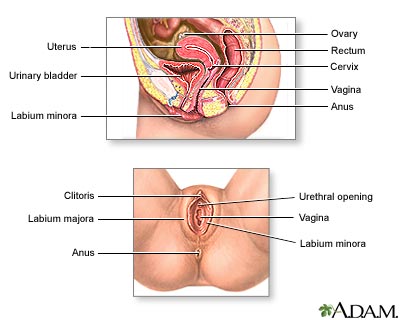Symptoms & Signs
- A feeling as if sitting on a small ball
- Difficult or painful sexual intercourse
- Frequent urination or a sudden, urgent need to empty the bladder
- Low backache
- Pain during intercouse
- Protruding of the uterus and cervix through the vaginal opening
- Repeated bladder infections
- Sensation of heaviness or pulling in the pelvis
- Vaginal bleeding or increased vaginal discharge
Many of the symptoms are worse when standing or sitting for long periods of time.
Diagnosis & Tests
A pelvic examination performed while the woman is bearing down (as if trying to push out a baby) will show how far the uterus comes down.
- Uterine prolapse is mild when the cervix drops into the lower part of the vagina.
- Uterine prolapse is moderate when the cervix drops out of the vaginal opening.
The pelvic exam may reveal that the bladder, front wall of the vagina (cystocele), or rectum and back wall of the vagina (rectocele) are entering the vaginal area. The urethra and bladder may also be positioned lower in the pelvis than usual.
A mass may be noted on pelvic exam if a tumor is causing the prolapse (this is rare).
Pictures & Images
Female reproductive anatomy
External structures of the female reproductive anatomy include the labium minora and majora, the vagina and the clitoris. Internal structures include the uterus, ovaries and cervix.
-
Uterine prolapse: Overview, Causes
-
Uterine prolapse: Symptoms & Signs, Diagnosis & Tests
-
Uterine prolapse: Treatment
Review Date : 5/12/2008
Reviewed By : Linda J. Vorvick, MD, Medical Director, MEDEX Northwest Division of Physician Assistant Studies, University of Washington, School of Medicine; Susan Storck, MD, FACOG, Chief, Eastside Department of Obstetrics and Gynecology, Group Health Cooperative of Puget Sound, Redmond, Washington; Clinical Teaching Faculty, Department of Obstetrics and Gynecology, University of Washington School of Medicine. Also reviewed by David Zieve, MD, MHA, Medical Director, A.D.A.M., Inc.
![]()
